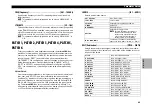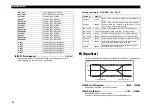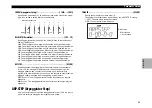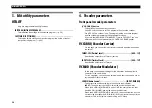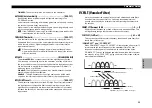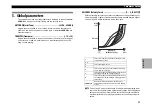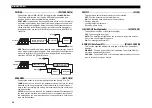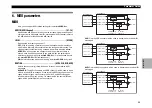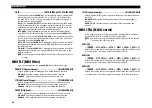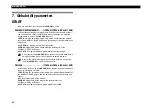
Parameter Guide
47
VEL INT (Velocity Intensity)................................................... [–63...+63]
This specifies how your keyboard velocity (playing strength) will affect the
amplitude of EG1. Higher settings of this parameter will allow changes in
your keyboard velocity to produce greater differences in EG amplitude.
EG2
Here you can adjust the settings for the AMP EG, which applies time-vari-
ant change to the volume. Using the AMP EG settings, you can make the
volume change as time passes. Create the desired volume curve by adjust-
ing the ADSR parameters; ATTACK, DECAY, SUSTAIN, RELEASE.
NOTE
You can use EG2 as a Virtual Patch source to modulate parameters oth-
er than volume. (
EG1 and EG2
As the EG1 (Filter EG) changes the cutoff frequency, the tone will change.
However, the overall character of the sound will also depend on the volume
changes produced by the EG2 (Amplifier EG). For example, setting a long
decay for the Filter EG (EG1) will produce a different sound depending on
how the decay is set in the Amp EG (EG2). It’s a good idea to be aware of
both the EG 1(tone) settings and the EG2 (volume) settings as you’re edit-
ing.
ATTACK (Attack level EG2)....................................................... [000...127]
Specifies the time from note-on (when the key is pressed) until the attack
level (maximum value of the envelope) is reached.
DECAY (Decay level EG2) ......................................................... [000...127]
Specifies the time from when the attack level is reached until the sustain
level (SUSTAIN) is reached.
SUSTAIN (Sustain level EG2) ................................................... [000...127]
Specifies the volume that will be maintained after the decay time has
elapsed, as long as you continue holding the key.
RELEASE (Release time EG2) ................................................... [000...127]
Specifies the time from note-off (when the key is released) until the level
reaches 0.
VEL INT (Velocity Intensity) ...................................................[–63...+63]
This specifies how your keyboard velocity (playing strength) will affect the
amplitude of EG2. Higher settings of this parameter will allow changes in
your keyboard velocity to produce greater differences in EG amplitude.
EG3
Here you can adjust the settings of EG3. Create the desired curve by
adjusting the ADSR parameters; ATTACK, DECAY, SUSTAIN, RELEASE.
NOTE
You can use EG3 as a Virtual Patch source to modulate parameters oth-
er than filter cutoff (EG1) or volume (EG2). (
ATTACK (Attack time EG3) .......................................................[000...127]
Specifies the time from note-on (when the key is pressed) until the attack
level (maximum value of the envelope) is reached.
DECAY (Decay time EG3) .........................................................[000...127]
Specifies the time from when the attack level is reached until the sustain
level (SUSTAIN) is reached.
SUSTAIN (Sustain level EG3)....................................................[000...127]
Specifies the volume that will be maintained after the decay time has
elapsed, as long as you continue holding the key.
RELEASE (Release time EG3) ...................................................[000...127]
Specifies the time from note-off (when the key is released) until the level
reaches 0.
VEL INT (Velocity Intensity) ...................................................[–63...+63]
This specifies how your keyboard velocity (playing strength) will affect the
amplitude of EG3. Higher settings of this parameter will allow changes in
your keyboard velocity to produce greater differences in EG amplitude.
LFO 1, LFO 2
Each timbre contains two LFOs. An LFO produces a cyclic change that can
be used to modulate the pitch, tone, or volume of the sound.
NOTE
LFO1 and LFO2 can be used as Virtual Patch sources to apply modula-
tion to a variety of parameters. (
Parameter Guide

















